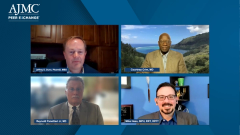
Role of Non-Medication Strategies in COPD Treatment Pathway
Nonmedication COPD strategies, such as pulmonary rehabilitation, are highlighted.
Episodes in this series

Jeffrey D. Dunn, PharmD, MBA: [Summarize] the nonmedication strategies that we can use to optimize the management of COPD [chronic obstructive pulmonary disease].
Mike Hess, MPH, RRT, RPFT: The very first one I’ll throw out there was one [DrPanettieri] mentioned toward the beginning: pulmonary rehabilitation. Pulmonary rehabilitation is criminally underutilized for a variety of reasons. A lot of clinicians don’t think to prescribe it, or they don’t think that their [patient] is going to be able to complete it. In certain areas, there’s a lack of available good-quality programs, but it’s one of the leading nonpharmacological therapies that we have. It speaks to the social and activity elements of it. It’s where a lot of [patients] learn how to use their inhalers properly. They learn nutrition, good exercise, those sorts of thing.
Right on the same level as that is, of course, treatment for tobacco [addiction] and tobacco cessation. Even after diagnosis, a lot of [patients] still struggle to quit because it’s that tenacious of an addiction. We need to make sure we’re addressing both the pharmacological and the nonpharmacological sides of that with good counseling and motivational interviewing.
Jeffrey D. Dunn, PharmD, MBA: You’re on one side and I’m on the other side, so in your opinion, how could we better work together to treat a patient? I’ve also seen situations where patients get frustrated because you’re teaching them something, we have a care manager outreach, and you’re getting information from the office. How would you see that better fitting together? We all have the same goals, but we’re coming at it from different perspectives. How can we better work together?
Mike Hess, MPH, RRT, RPFT: It’s an issue that we see throughout the health care continuum. We talked about care coordination. As somebody is transitioning from the hospital to the home, one of the biggest breakdowns is communication. Because who’s responsibility is it at what point? It’s a complicated question with a simple, yet complicated answer: communication. We need to make sure we’re all rowing the boat together. We all need to make sure we’re talking with each other. That includes the patient and the caregiver too. We need to make sure we’re all part of a team and truly sharing those decisions together.
Jeffrey D. Dunn, PharmD, MBA: We’re going to wrap up some of those formulary questions and advice to payers. I will give a plug to payers. We have data that are unavailable to other people, so we know if [patients are] filling their medications and what other doctors they’re seeing. We have a pretty good perspective of their other comorbidities. We have a responsibility to better treat these patients and, to your point, better communicate to those who are on the front lines with these patients. I put that out there to my payer colleagues. We have that responsibility. We have the data, but we need to do a better job of communicating that and coordinating care.
Transcript edited for clarity.
Newsletter
Stay ahead of policy, cost, and value—subscribe to AJMC for expert insights at the intersection of clinical care and health economics.






























































